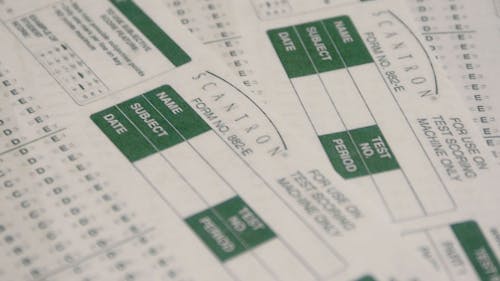Tech Tuesday: Can you cheat a Scantron?

With final exams just around the corner, students are beginning to prepare for anything they might encounter on the exam.
One common section of an exam is multiple choice, which is often completed using a Scantron. Scantron is used in 98 percent of the top school districts in the United States, according to Scantron.com.
Students are asked to fill in their forms using No. 2 pencils, which seems oddly specific when taking an exam. However, this is because that particular size of pencil has the proper thickness and color to allow a Scantron machine to read the form, according to howeverythingworks.org.
Forms are passed through a machine, which then identifies where a pencil is made. If that pencil mark is in the same area that the machine knows the right answer’s mark would be, then the problem is noted correct, according to the site.
Older machines would shine light onto the form and sense the light passing through. Any area where light did not pass through was deemed to be a marking, and was graded as such, according to the site.
These machines would absorb blue wavelengths of light, so a region that showed the sensor a wavelength other than blue would not be determined a marking, according to the site.
Pencil was desired over pen because pencils make very opaque marks, ensuring that no light can get through to the other side. Pencil marks are black, so they would absorb any light and prevent anything from getting through, according to the site.
Although black pens also absorb all light, they often were not opaque enough for the machine to acknowledge a marked circle. Blue pens do not absorb blue wavelengths of light, so they would not be registered by the machine at all, according to the site.
Modern machines reflect light off the form to determine the location of a marking, making it possible to have double-sided forms. These machines are even able to recognize black pen markings, according to the site.
The newer machines typically no longer require No. 2 pencils, as they can differentiate between proper markings and mistakes, according to the site.
Sometimes, people attempt to take advantage of the Scantron grading system by trying to make it register wrong answers as true. Modern machines do not fall for these tricks and will hurt the test taker, according to snopes.com.
Rumors about how students can beat the grading system often include the use of lip balm, requiring the test taker to the cover each bubble, only the filled in bubbles, the markings on the side or other areas, according to the site.
These methods would reflect light back to the machine, making it think there was a marking where the lip balm was applied. The machine would then mark the problem wrong, because the “marked” area is not where the answer is meant to be, according to the site.
Having too many additional markings will make the machine question the legitimacy of the form and mark it for hand grading. If a form is hand graded, the truth of the situation would be revealed, according to the site.
Regardless of the method, cheating on an exam is a direct violation of the Rutgers University Academic Integrity Policy, and offenders will be reprimanded appropriately, according to the website for Rutgers Office of Student Conduct.
Harshel Patel is a School of Arts and Sciences sophomore majoring in molecular biology and biochemistry. He is the digital editor of The Daily Targum. He can be found on Twitter @harshel_p.



